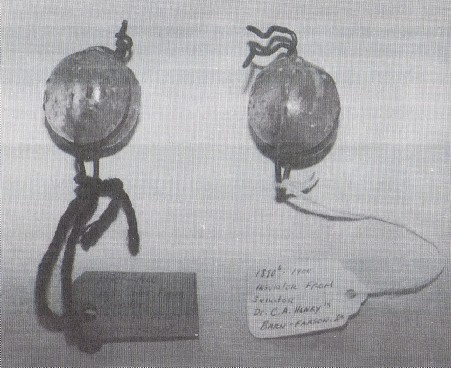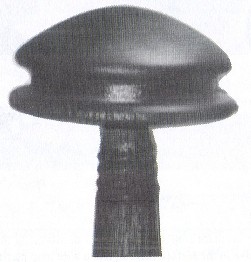Mac's Believe It or Not!
by John McDougald
Reprinted from "Crown Jewels of the Wire", December 1999, page 30
Attending as many insulators shows and club meetings during the year as
possible has been one of my collecting priorities. One is never disappointed if
they are looking for newly discovered insulators.
Such was the case at the 1999
NIA Central Region show in Crown Point, Indiana. I had never seen the L. FUNK /
PAT PEND twist lock porcelain insulator before that Dan Raber brought to show.
(See CJ's PIN article, November 1999) Also of interest were two very unusual
insulators that were brought to the show by Tom Murphy and purchased by Rick
Soller.

Measuring a little over 1" in diameter, these grooved, glass
insulators
were tagged: "1890s -1900 Insulator from
Senator Dr. C.A. Henry's barn,
Farson, IA"
The glass was light aqua in color and very crude. There looked to be
embossing which was hand-engraved. Curiously, the two pieces were made in two
different molds. And, I am sure they were hand molded, for it would be very
difficult to mold the wire into the glob of glass by any other method.

Bob Stahr had found in the April 14, 1903 U.S. PATENT OFFICE records the
following information regarding the Claydon Patent.
- - - - - - - - - -
725,044. INSULATOR. CHARLES CLAYDON, Searcy, Tex. Filed Sept. 19, 1902.
Serial No. 124054 (No model.)

Claim. --- 1. An insulator consisting of a block of insulating material
having a wire-supporting groove in the surface thereof, and a wire loop
partially embedded in said block with the side members thereof spaced apart and
emerging from the block on opposite sides of and at points remote from said
groove.
2. An insulator consisting of a block of insulating material having a wire-supporting groove in the surface thereof, a wire loop partially embedded in
said block with the side members thereof spaced apart and emerging from the
block on opposite sides of and at points remote from said groove, and a guy wire
disposed in said groove and embracing said block and provided with means for
engaging a line wire.
3. An insulator consisting of a block of insulating
material having an endless wire loop partially embedded therein, a guy wire
embracing said block through said loop transversely thereof and provided with
means for supporting a line-wire, the side members of said loop emerging from
said block on opposite sides of said guy wire and disposed out of contact
therewith, and a tie-wire connected to the projecting portion of said loop.
4.
An insulator comprising a block of insulating material, and an endless loop
formed of a section of wire twisted together near the ends with the extremities
extended in. opposite directions, and said twisted portion and extended ends
embedded in said block, substantially as described.
- - - - - - - - - -
Now, this insulator ended up in Iowan barn, but you Texans in the Searcy area
might want to do a little research on Charles Claydon to see if the insulators
may have been distributed in your part of the country. Believe It Or Not! they
are really interesting historical pieces.
Bob Moss of Millville, New Jersey shares two interesting pieces from his
town's insulator-production era.

CD 176 Whitall Tatum Co. No. 12 "Mushroom" in an
ice aqua covered
with a copper top.

A beautiful advertising piece from the Armstrong Cork Company.
The double
candleholder has an etched base as well as an etched
medallion bearing the
company's name.
| 